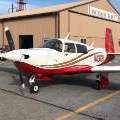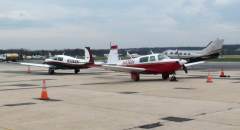-
Posts
4,867 -
Joined
-
Last visited
-
Days Won
67
Content Type
Profiles
Forums
Blogs
Gallery
Downloads
Media Demo
Events
Everything posted by 201er
-
Quote: Piloto Mike, what you describe is not uncomon for Mooneys in high crosswind conditions particularly on icy runways. I had almost hit the grass or snow banks on the side of the runway four times. What happens is the plane does not settle on the ground below stall speed due to an air cushion build up between the wing and the ground. This is what causes the plane to float during flare. During this condtion the airspeed is low for rudder effectivenes and the tire friction is poor due to the remaining lift. To eliminate the air cushion effect the touchdown needs to be done with no flaps. Like many Mooney pilots under suspected crosswind conditions I approach the runway with full flaps at 70kts and raise them when at about 5ft from touchdown on the flare. This will cause the plane to slightly pitch up and settle gently on the ground. Since using this procedure never had the slightest tendency to weathervane into the wing. You can also do the above with no flaps on the approach but I found that visibility over the nose is much better with full flaps. It is a safe procedure that can be practiced at any time. José
-
Ok, but even if my speed was dead on, I feel like there still would be some span of time when you face the choice of drifting across the runway or crabbing into the wind WHILE THREE TIRES ARE ON THE GROUND! And there's little weight on them. Of course I retracted flaps the moment I was down but it took a long time to regain control. I didn't expect this to happen or I would have went around. By the time I realized I should have went around there wasn't enough runway left to go around.
-
During a recent unexpectadly crosswind landing I encountered a situation upon landing that I did not like. I was high and fast most of the way in and employed a slip to get down. Touchdown was on the fast end and not the way I'd normally land. This is when the trouble started. During the initial roll, the airplane seemed to be skidding a bit sideways. What it appeared like was that the airplane was drifting sideways across the runway and rudder inputs that I would make would make it skid relative to going straight ahead on the runway. In other words, it seems to me that ground effect was still keeping the majority of the weight off the wheels and the wind was drifting the plane sideways. This sidways drift caused me to correct by tuning the nose with the rudder putting me into a crab while on the ground and causing wheels to skid. So it seems like the only two options were to point straight and be pushed sideways on the runway by the wind or to steer into the wind and then have the wheels not be aligned with the direction of motion. Anyway, this was a total mess and I was terrified that the gear was going to collapse. The moment I shut down I got out and checked the wheels. Surprisingly there wasn't any noticeable wear on the tires or anything bent. Besides better speed management, what advice do you have for controlling the airplane on the ground right after a crosswind landing when the wind is trying to blow the plane one way and the wheels are telling it to go another? I think I did use aileron into the wind as well but with both wheels on the ground it doesn't do much.
-
I'm curious if I've been leaning too aggressively to get the best warm up possible. I run the engine at 1000RPM and pull the mixture out as far as it will go before there is an RPM drop. I wouldn't be surprised if this is well LOP (although I've never actually checked). Would it in fact be better to be 50ROP to gain the maximum heating possible during warm up? Or is this all different at such a low idling power setting?
-
Since I'm looking to having the yokes redone eventually as well, I want to ask the guys who got the leather. It looks like the leather yokes are notably thicker than the standard yokes. Is it hard to get a good grip in your hand that way or does it compress? Does it tire your hand to be wrapped around a wider yoke this way?
-
Do you report the overhaul to the insurance company to increase hull value by the newly overhauled engine?
-
-
-
From the album: Mooney Fly In KFDK
-
From the album: Mooney Fly In KFDK
-
Ok. Anyone disagree or know a reason not to?
-
I've been wondering if it's ok to leave the cowl flaps closed to experdite engine/oil warm up while idling on the ground on cold days. Someone told me not to do that because closed cowl flaps lead to uneven cooling of the engine. What do you guys think? Any tips for improving warm up when it's cold and you actually need the heat?
-

Request - M20J Cruise Perf Numbers for Benchmark!
201er replied to testwest's topic in Modern Mooney Discussion
Quote: GeorgePerry If you can find a bone stock J that'll do 159 KTAS on 8.8 GPH, then somehow it's defying the laws of physics. I don't have any "cruise" numbers collected on a data card handy, but my 700+ hours in Mooney's tells me your model’s underlying assumptions must be inaccurate. No M20J is that fast on that little gas. A more realistic number, and what I’ve seen, is 67% power would yield 156-162 KTAS at 10.2-10.8 GPH ROP. With EGT set 30 deg LOP that should yield about 147-152 KTAS at 8.6-8.9. And those performance figures assume, proper control rigging, a fresh wax job, and no bugs on the leading edges. -
The time change is a bigger problem for me than the destination change because I have to leave no later than 1PM to get somewhere. The extra distance doesn't help either. Would it be alright to keep it at 11:30 to start? I expect to be getting there around 11AM anyway. And I'm confirming for 2 people, no fuel.
-
Peter said he'll be in KGED Sunday by coincidence on personal business. To me it doesn't make a whole lot of difference as look as I'm sure it will be a worthwhile fly in. Once I'm going xcountry, 10 minutes here and there doesn't make a heck of a difference.
-
So is everyone still going? I'm planning to come (2 people, 1 mooney).
-
I like to have my mechanic change the oil not only to get it relaced but also because it gives me a chance to have my engine looked over by an expert. I pay for the oil to be changed but I get a virtually free look over of the state of the engine while I'm at it. Besides, I usually have a list of minor squawks to take care of by the time 50 hours comes around. Same on the car. I'll change the oil myself only every other time, that way the mechanic can top off the fluids and take care of the stuff I'm not supplied on.
-

Where are you flying this weekend Nov 18-20
201er replied to DrBill's topic in Miscellaneous Aviation Talk
Instrument cross country flight on Saturday with instructor, destination to be determined. KGED for Midatlantic Mooney Fly in on Sunday. -
Quote: Shadrach 1) Your premise is flawed. There is no statistical data to show that LOP ops will have any affect on TBO. Even the most staunch proponents of LOP ops will tell you that. Sure, presuming TBO is TBO is 2000... if you fly slower while turning the prop at the same speed, you'll bring your engine closer to the TBO time in order to cover the same distance. 2) Even if you could quantify the difference is a plane with an engine that has gone 300,000nm in 2000hrs going to be worth less than a plane that has gone 300,000nm in 1900hrs? Well, we know how engine time plays a role in appraising an airplane. Since the buyer can't accurately assess the inners of the engine, they have to look at the hours. 3) The number of air miles logged per engine is affected by so many variables (wind, routing, holds, restricted areas) as to make the 4 to 6kts you lose by "properly" running LOP (those of you running still 50LOP at 8500 take note) a rounding error. Additionally, for shorter VFR flights below 3500ft speed difference LOP vs ROP is very, very small, however savings in FF can approach 40%. Are all of your flights purely travel based? Is a 1hr joy ride anymore satisfying at ~160kts vs ~155kts? Is that same joy ride more satisfying at ~16.5GPH vs ~10.5GPH? Wow. I am simply amazed to what lengths people are willing to bend the numbers in order to justify their point of view. 16.5GPH??? Really? Where did you get that from? Both you and I are flying IO-360s. Even for 75% cruise at 100ROP (not 50 or 25), it burns 12.5gph at sea level in the most inefficient configuration possible! 75% power LOP on the other hand would burn 10gph. That's only 20% savings. Once you factor an efficient ROP cruise at 10.5GPH 25ROP vs 9-10GPH 70-75% power, the difference isn't particularly big at all. While I appreciate the lower temperatures and gas savings, I don't think it's necessary to pretend like it makes THAT big of a difference in fuel savings on our 200HP engines.
-
Quote: Jeff_S Mike, I hereby nominate you as the winner of "Most Inquisitive" on the Forum. I am amazed at the things you think of. I don't say this to be condescending or rude, and I sense that you are really enjoying getting to know your Mooney and all the idiosyncracies of airplane operation. I just hope that somewhere in all this you get out and just fly your airplane and enjoy the amazement of cruising along with the birds. At some point all the technical mumbo jumbo goes away and you just start to appreciate the sheer joy of flying, without analyzing. No offense meant, so please don't take any. Tailwinds!
-
On one hand LOP saves gas, but has anyone considered the impact on value of the plane (specifically engine)? If LOP is better for the engine and helps it make it to or past normal TBO, that's great if you're keeping it. However, if LOP results in a net speed loss, that means you're taking more time to get there and therefore putting more hours on the engine. You saved on gas, took more time, but also put a little more time on the engine. Just like the gas savings, this time adds up in the long run. So does the gas saving still outweigh the deduction in engine time for resale value? Has anyone considered this?
-
Wow, a 150kt wind in the Mooney would put you at a dead stand still! Funny how you just shrug it off in what you're flying. Thanks for sharing.
-
Tie Down Ropes - $10 Quarterly Waxing - $300 Airplane Cover - $500 Yearly Tie Downs - $1200 Having your plane nearby and enough time/money left to actually fly it - PRICELESS
-
Quote: rob I use "climbing" or "descending" instead of "leaving" or "out of." It's how I was taught and I figure a little extra description can't hurt. The difference between an M20T and M20P as far as ATC is concerned is 500fpm climb, 200fpm descent, and a different LAHSO category. See this link: http://www.aopa.org/whatsnew/acdesig.html



